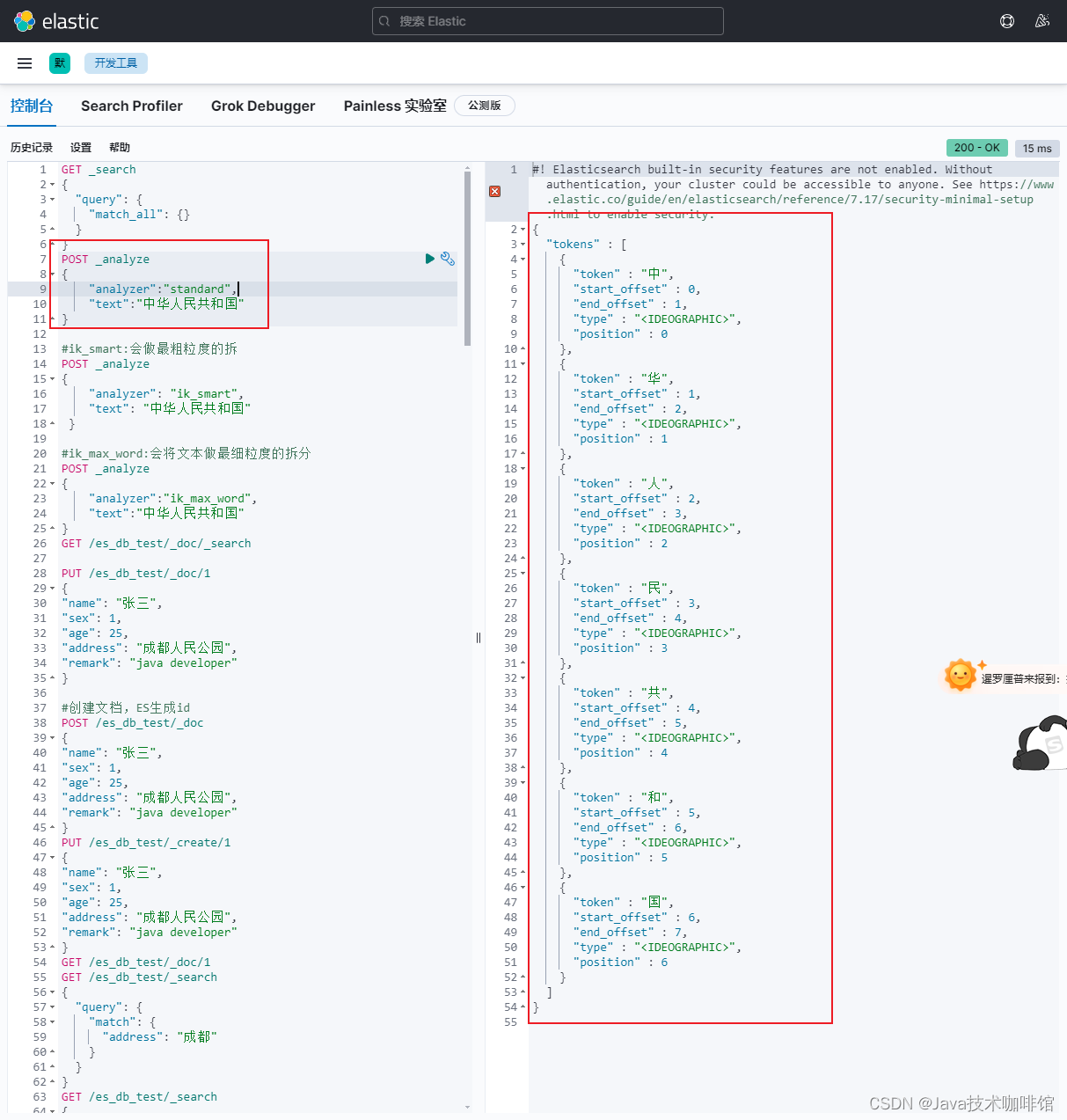文本分析基本概念
官网:Text analysis | Elasticsearch Guide [7.17] | Elastic
官网称为文本分析,这是对文本进行一直分析处理的方式,基本处理逻辑是为按照预先制定的分词规则,把原本的文档进行分割成多个小颗粒度的词项,颗粒度的大小取决于分词器的配置规则。
不同文本分析结果如下:
POST _analyze
{"analyzer":"standard","text":"中华人民共和国"
}
#ik_smart:会做最粗粒度的拆
POST _analyze
{"analyzer": "ik_smart","text": "中华人民共和国"}
#ik_max_word:会将文本做最细粒度的拆分
POST _analyze
{"analyzer":"ik_max_word","text":"中华人民共和国"
}
文本分析发生时间
Index and search analysis | Elasticsearch Guide [7.17] | Elastic
文本分析处理发生在 Index Time 和 Search Time 两个时间。
- Index Time:文本写入并创建倒排索引时期,其分词逻辑取决于映射参数analyzer。
- Search Time:搜索执行时期,其分词仅对搜索词产生作用。
文本分析构成
Anatomy of an analyzer | Elasticsearch Guide [7.17] | Elastic
- 切词器(Tokenizer):定义切词(分词)逻辑
- 词项过滤器(Token Filter):分词之后的单个词项的处理逻辑
- 字符过滤器(Character Filter):处理单个字符
分词器:Tokenizer
tokenizer 是文本分析的核心组成部分之一,其主要作用是分词,或称之为切词。主要用来对原始文本进行细粒度拆分。拆分之后的每一个部分称之为一个 Term,或称之为一个词项。可以把切词器理解为预定义的切词规则。官方内置了很多种切词器,默认标准切词器standard。
词项过滤器:Token Filter
词项过滤器用来处理切词完成之后的词项,例如把大小写转换,删除停用词或同义词处理等。官方同样预置了很多词项过滤器,基本可以满足日常开发的需要。当然也是支持第三方也自行开发的。
停用词
在切词完成之后,会被干掉词项,即停用词。停用词可以自定义
英文停用词(english):a, an, and, are, as, at, be, but, by, for, if, in, into, is, it, no, not, of, on,
or, such, that, the, their, then, there, these, they, this, to, was, will, with。
中日韩停用词(cjk):a, and, are, as, at, be, but, by, for, if, in, into, is, it, no, not, of, on, or, s,
such, t, that, the, their, then, there, these, they, this, to, was, will, with, www。
GET _analyze
{
"tokenizer": "standard",
"filter": ["stop"],
"text": ["how are you"]
}自定义过滤器
# 自定义 filter
DELETE test_token_filter_stop
PUT test_token_filter_stop
{"settings": {"analysis": {"filter": {"my_filter": {"type": "stop","stopwords": ["you"],"ignore_case": true}}}}
}
GET test_token_filter_stop/_analyze
{"tokenizer": "standard", "filter": ["my_filter"], "text": ["how are you"]
}同义词
同义词定义规则:
- a, b, c => d:这种方式,a、b、c 会被 d 代替。
- a, b, c, d:这种方式下,a、b、c、d 是等价的。
PUT test_token_filter_synonym
{"settings": {"analysis": {"filter": {"my_synonym": {"type": "synonym","synonyms": [ "good, nice => excellent" ] //good, nice, excellent}}}}
}
GET test_token_filter_synonym/_analyze
{"tokenizer": "standard", "filter": ["my_synonym"], "text": ["good"]
}字符过滤器:Character Filter
分词之前的预处理,过滤无用字符。
PUT <index_name>
{"settings": {"analysis": {"char_filter": {"my_char_filter": {"type": "<char_filter_type>"}}}}
}type:使用的字符过滤器类型名称,可配置以下值:
- html_strip
- mapping
- pattern_replace
HTML 标签过滤器:HTML Strip Character Filter
字符过滤器会去除 HTML 标签和转义 HTML 元素,如 、&
PUT test_html_strip_filter
{"settings": {"analysis": {"char_filter": {"my_char_filter": {"type": "html_strip", // html_strip 代表使用 HTML 标签过滤器"escaped_tags": [ // 当前仅保留 a 标签 "a"]}}}}
}
GET test_html_strip_filter/_analyze
{"tokenizer": "standard", "char_filter": ["my_char_filter"],"text": ["<p>I'm so <a>happy</a>!</p>"]
}参数:escaped_tags:需要保留的 html 标签
字符映射过滤器:Mapping Character Filter
通过定义映替换为规则,把特定字符替换为指定字符
PUT test_html_strip_filter
{"settings": {"analysis": {"char_filter": {"my_char_filter": {"type": "mapping", // mapping 代表使用字符映射过滤器"mappings": [ // 数组中规定的字符会被等价替换为 => 指定的字符"滚 => *","垃 => *","圾 => *"]}}}}
}
GET test_html_strip_filter/_analyze
{//"tokenizer": "standard", "char_filter": ["my_char_filter"],"text": "你个垃圾废物!滚"
}正则替换过滤器:Pattern Replace Character Filter
PUT text_pattern_replace_filter
{"settings": {"analysis": {"char_filter": {"my_char_filter": {"type": "pattern_replace", // pattern_replace 代表使用正则替换过滤器 "pattern": """(\d{3})\d{4}(\d{4})""", // 正则表达式"replacement": "$1****$2"}}}}
}
GET text_pattern_replace_filter/_analyze
{"char_filter": ["my_char_filter"],"text": "手机号是18868686688"
}倒排索引的数据结构
当数据写入 ES 时,数据将会通过 分词 被切分为不同的 term,ES 将 term 与其对应的文档列表建立一种映射关系,这种结构就是 倒排索引。

为了进一步提升索引的效率,ES 在 term 的基础上利用 term 的前缀或者后缀构建了 term index, 用于对 term 本身进行索引,ES 实际的索引结构如下图所示:

这样当我们去搜索某个关键词时,ES 首先根据它的前缀或者后缀迅速缩小关键词的在 term dictionary 中的范围,大大减少了磁盘IO的次数。
- 单词词典(Term Dictionary) :记录所有文档的单词,记录单词到倒排列表的关联关系
- 常用字典数据结构:
-
数据结构 优缺点 排序列表Array/List 使用二分法查找,不平衡 HashMap/TreeMap 性能高,内存消耗大,几乎是原始数据的三倍 Skip List 跳跃表,可快速查找词语,在lucene、redis、Hbase等均有实现。相对于TreeMap等结构,特别适合高并发 Trie 适合英文词典,如果系统中存在大量字符串且这些字符串基本没有公共前缀,则相应的trie树将非常消耗内存 Double Array Trie 适合做中文词典,内存占用小,很多分词工具均采用此种算法 Ternary Search Tree 三叉树,每一个node有3个节点,兼具省空间和查询快的优点 Finite State Transducers (FST) 一种有限状态转移机,Lucene 4有开源实现,并大量使用
- 倒排列表(Posting List)-记录了单词对应的文档结合,由倒排索引项组成
- 倒排索引项(Posting):
- 文档ID
- 词频TF–该单词在文档中出现的次数,用于相关性评分
- 位置(Position)-单词在文档中分词的位置。用于短语搜索(match phrase query)
- 偏移(Offset)-记录单词的开始结束位置,实现高亮显示
Elasticsearch 的JSON文档中的每个字段,都有自己的倒排索引。
可以指定对某些字段不做索引:
- 优点︰节省存储空间
- 缺点: 字段无法被搜索





)



的使用)


 函数)









